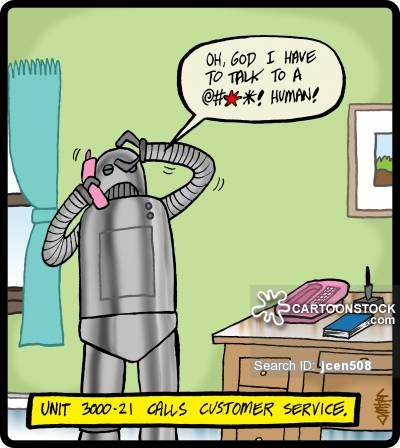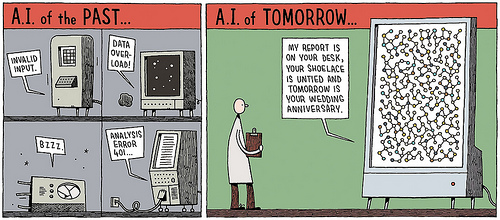February 15, 2016 – This is part two of seven postings that I am sharing with my readers. The words, for the most part, are not mine, but those of Peter Diamandis. In Part 1 Diamandis shared expert insights into current and near future advances related to the Internet of Things (IoT). In this posting our focus is on recent and anticipated breakthroughs in artificial intelligence (AI). Diamandis’ expert on AI is Stephen Gold, CMO and VP of Business Development for IBM Watson, the technology made famous by beating the best humans in the game of “Jeopardy.”
———-
Artificial intelligence is the ability of a computer to understand what you’re asking and then infer the best possible answer from all the available evidence. You may think of AI as Siri or Google Now on your iPhone, Jarvis from Iron Man or IBM’s Watson. Progress of late is furious — an AI R&D arms race is underway among the world’s top technology giants. Soon AI will become the most important human collaboration tool ever created, amplifying our abilities and providing a simple user interface to all exponential technologies. Ultimately, it’s helping us speed toward a world of abundance. The implications of true AI are staggering. Here are the top five breakthroughs from the past three years to illustrate just some of the advances that have been made.
Recent Top 5 Breakthroughs in AI: 2011 to 2015
1. IBM Watson wins “Jeopardy”
In a demonstration of the integration of natural language processing, machine learning (ML), and big data in 2011, IBM’s AI system, dubbed “Watson,” won a game of Jeopardy against the top two all-time champions. This was a historic moment, the “Kitty Hawk moment” for artificial intelligence. States Gold, “It was really the first substantial, commercial demonstration of the power of this technology…..We wanted to prove a point that you could bring together some very unique technologies: natural language technologies, artificial intelligence, the context, the machine learning and deep learning, analytics and data and do something purposeful that ideally could be commercialized.”
2. Siri/Ask Google redefine human-data interaction
In the past few years, systems like Siri and Google Now have opened our minds to the idea that we don’t have to be tethered to a laptop to have seamless interaction with information. In this model, AIs move from speech recognition to natural language interaction, to natural language generation, and eventually to an ability to write as well as receive information.
3. Deep Learning demonstrates how machines learn on their own, advance and adapt
“Machine learning is about man assisting computers. Deep learning is about systems beginning to progress and learn on their own,” states Gold. “Historically, systems have always been trained. They’ve been programmed. And, over time, the programming languages changed. We certainly moved beyond FORTRAN and BASIC, but we’ve always been limited to this idea of conventional rules and logic and structured data.” As we move into AI and cognitive computing, we’re witnessing the ability of computers to do more unaided/unassisted learning.
4. Image Recognition and interpretation rivals what humans can do
Image recognition has exploded over the last few years. Facebook and Google Photos, for example, contain tens of billions of images on their platform. With this data set, they (and many others) are developing technologies going beyond facial recognition, providing algorithms that can label what is in the image: a boat, plane, car, cat, dog, and so on. The crazy part is the algorithms are better than humans at recognizing images. The implications are enormous. “Imagine,” says Gold, “an AI able to examine an X-ray or CAT scan or MRI to report what looks abnormal.”
5. AI Apps Proliferate: Universities scramble to adopt AI curriculum
As AI begins to impact every industry and every profession, schools and universities are ramping up their AI and Machine Learning curriculum. IBM, for example, is working with over 150 partners to present both business and technology-oriented students with cognitive computing curricula.
So what’s in store for the near future?
Anticipated Top AI Breakthroughs: 2016 to 2018
Here are Gold’s predictions that represent enormous business opportunities for entrepreneurs and investors.
1. Nextgen AI systems Beat the Turing Test
Alan Turing created the Turing Test half a century ago as a way to determine a machine’s ability to exhibit intelligent behavior indistinguishable from that of a human. Loosely, if an artificial system passed the Turing Test, it could be considered “AI.” Gold states, “that for all practical purposes, these [AI] systems will pass the Turing Test” in the next three-year period. Perhaps more importantly, if these AI systems do reach this milestone it will accelerate the conversation about proper use of the technology and applications.
2. All five human senses (including taste, smell and touch) will be part of the computing experience
AIs will begin to sense and use all five senses. “The sense of touch, smell, and hearing will become prominent in the use of AI,” states Gold. “It will begin to process all that additional incremental information.” When applied to the computing experience, we will engage with a much more intuitive and natural ecosystem as a result.
3. Solving Big Problems: Detect & Deter Terrorism, Manage Global Climate Change
AI will help solve some of society’s most daunting challenges. Gold continues, “We’ve discussed AI’s impact on healthcare. We’re already seeing this technology being deployed in governments to assist in the understanding and preemptive discovery of terrorist activity.” We’ll see revolutions in how we manage climate change, redesign and democratize education, make scientific discoveries, leverage energy resources, and develop solutions to difficult problems.
4. Leverage all health data (genomic, phenotype, social) to redefine medicine
“I think AI’s effect on healthcare will be far more pervasive and far quicker than anyone anticipates,” says Gold. “Even today, AI/Machine Learning is being used in oncology to identify optimal treatment patterns.” But it goes far beyond this. AI will match clinical trials with patients, drive robotic surgeons, read radiological findings and analyze genomic sequences.
5. AI will be woven into the very fabric of our lives – physically and virtually
Ultimately, during the AI revolution taking place in the next three years, AI will be integrated into everything around us, combining sensors and networks and making all systems “smart.” AI will push forward the ideas of transparency, of seamless interaction with devices and information, making everything personalized and easy to use. We’ll be able to harness that sensor data and put it into an actionable form, at the moment when we need to make a decision.
———-
Stay tuned for more of these forward thinking speculations courtesy of Peter Diamandis as he explores converging technology trends and advances.













Until we (or our machines) learn to detect and null ‘bugs’ (flaws) in computer code these ideas are interesting but infeasible. Where is the effort to cleanse automata of bugs?
Self correcting algorithms are already beginning to appear. Other than that it is human programmers who work with AI tools to debug them. As neuromorphic computing becomes the standard then machines will learn by observation of their human designers and users. This is where AI is going but we are probably a decade away from seeing neuromorphic technology displacing the current hardware/software duopoly that governs computing today. For some background read: https://www.21stcentech.com/when-will-computers-become-more-human-part-2/, a posting I wrote in 2009. And a more recent piece, https://www.21stcentech.com/artificial-intelligence-image/. You would find George Zarkadakis’ book, “In Our Own Image” a useful way to view the subject.